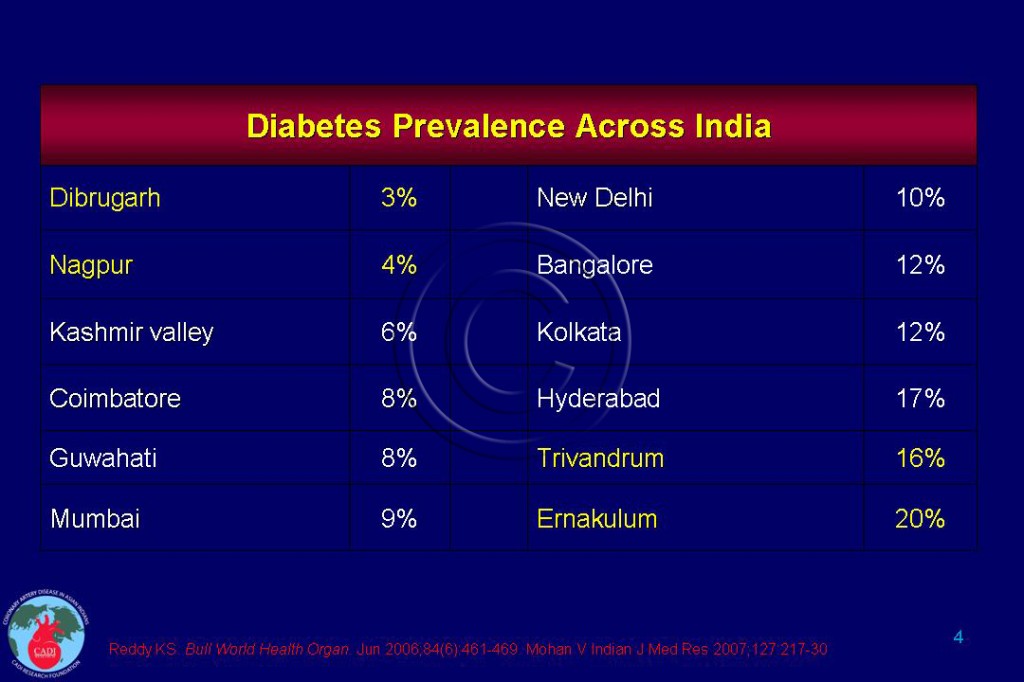Kerala ─ Diabetes Capital of India
- Kerala is the diabetes capital of India with a prevalence of diabetes as high as 20% ─ double the national average of 8%. 1, 2 In a large multi-center study involving nearly 20,000 subjects, the prevalence of diabetes in Thiruvananthapuram was 17% compared to 15% in Hyderabad and New Delhi, 4% in Nagpur and 3% in Dibrugarh.(Table 004). 1, 2
- Several studies from different parts of Kerala support the high prevalence of diabetes. One study from central Kerala reported a prevalence of diabetes at 20% and prediabetes at 11%.3 Another study from southern Kerala, showed a wide urban-rural gradient in age-standardized (30-64 years) prevalence of diabetes indicating an important role of lifestyle factors.4 The prevalence was 17% in urban, 10% in the midland, 7% in the highland, and 4% in the coastal regions.4
- Other studies have shown a prevalence of 11-19% in men and 15-22% in women with rural Keralans having paradoxically higher rates of diabetes than urban dwellers (Kerala Paradox). This is in sharp contrast to national data that shows the prevalence of diabetes to be double in urban areas than rural areas.5, 6
- The high literacy rate in this state does not seem to translate to health literacy. The high prevalence of diabetes is accompanied by poor detection. In one study, a surprising 11% (55% of all diabetes) were newly diagnosed.3
- The control rates of diabetes are even poor, which could lead to an increase in the burden of cardiovascular disease (CVD)─the foremost killer of people with diabetes.7 Among those with diagnosed diabetes, 17% received no treatment, 15% were on diet alone, and 68% were on medications.
- Only 40% of people with diabetes had adequate control of blood sugar. The fasting blood glucose was 153 mg/dl and the mean glycosylated hemoglobin level (A1C) was 8.1%. A1C level was above the recommended target of 7% in 60% of subjects.7 Insulin use ranged from 2%-10%.7
- Concomitant risk factors were common among the diabetics but inadequately addressed. One in two had high blood pressure but only 29% of patients were on antihypertensive treatment.7 Only 5% were on lipid-lowering agents and 90% had LDL-C >100 mg/dl ─ the foremost risk factor for heart attack in diabetic population. 7
- Unlike in other countries, high cholesterol and high blood sugar levels seem to be intertwined in Kerala, with increasing cholesterol levels as blood sugar levels increase.8 Diabetic subjects have cholesterol levels 17 mg/dL higher than nondiabetics.9 This association further underscores the crucial role of saturated fat as the “common soil” for diabetes, high cholesterol, and high rates of heart disease.10
- It is worth highlighting that 80% of diabetic patients die from heart disease. The high prevalence of diabetes, with abysmal control of blood sugar, blood pressure and lipids could very well explain why Kerala has the highest rate of heart disease in India, a rate double that of the US and 6 times higher than Japan and China (see Kerala Heart Disease).
- Increasing age, obesity, positive family history of diabetes, abnormal subscapular triceps skin fold ratio were all found to be associated with increased risk of diabetes.3 A simple cutaneous sign, acanthosis nigricans was independently associated with increased risk of diabetes and can be used as indication for screening for diabetes and prediabetes.3
- Indians develop diabetes about 10 years earlier and at a lower body mass index (BMI)─5 units (25 to 30 pounds) lower than in all other populations.11 This issue has not been adequately addressed in Kerala.
- Only a fifth of the diabetics are treated and adequately controlled. The high prevalence, poor detection and control of diabetes in Kerala with the highest standards of health care and literacy level compared to other states of India makes this disease doubly dangerous necessitating intensive education directed at doctors and the public alike.
Sources
1. Mohan V, Sandeep S, Deepa R, Shah B, Varghese C. Epidemiology of type 2 diabetes: Indian scenario. Indian J Med Res. Mar 2007;125(3):217-230.
2. Reddy KS, Prabhakaran D, Chaturvedi V, et al. Methods for establishing a surveillance system for cardiovascular diseases in Indian industrial populations. Bull World Health Organ. Jun 2006;84(6):461-469.
3. Menon VU, Kumar KV, Gilchrist A, et al. Prevalence of known and undetected diabetes and associated risk factors in central Kerala – ADEPS. Diabetes Res Clin Pract. Dec 2006;74(3):289-294.
4. Kutty VR, Soman CR, Joseph A, Pisharody R, Vijayakumar K. Type 2 diabetes in southern Kerala: variation in prevalence among geographic divisions within a region. Natl Med J India. 2000;13(6):287-292.
5. Thankappan K R, Shah B, Mathur P, et al. Risk factor profile for chronic non-communicable diseases: results of a community-based study in Kerala, India. Indian J Med Res. Jan 2010;131:53-63.
6. Shah B, Mathur P. Surveillance of cardiovascular disease risk factors in India: the need & scope. Indian J Med Res. Nov 2010;132(5):634-642.
7. Menon VU, Guruprasad U, Sundaram KR, Jayakumar RV, Nair V, Kumar H. Glycaemic status and prevalence of comorbid conditions among people with diabetes in Kerala. Natl Med J India. May-Jun 2008;21(3):112-115.
8. Kanaya AM, Wassel CL, Mathur D, et al. Prevalence and correlates of diabetes in South asian indians in the United States: findings from the metabolic syndrome and atherosclerosis in South asians living in america study and the multi-ethnic study of atherosclerosis. Metabolic syndrome and related disorders. Apr 2010;8(2):157-164.
9. Kutty VR, Soman CR, Joseph A, Kumar KV, Pisharody R. Random capillary blood sugar and coronary risk factors in a south Kerala population. J Cardiovasc Risk. 2002;9(6):361-367.
10. Enas EA, Senthilkumar A, Chennikkara H, Bjurlin MA. Prudent diet and preventive nutrition from pediatrics to geriatrics: current knowledge and practical recommendations. Indian heart journal. Jul-Aug 2003;55(4):310-338.
11. Enas EA MV. Metabolic Syndrome among Asian Indians: A population with high rates of diabetes and premature heart disease. . J Metabolic Syndrome. 2007;(in press).


